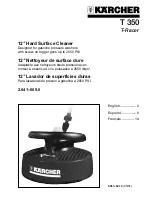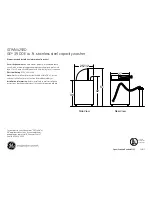
W
A
S
H
I
N
G
M
A
C
H
I
N
E
20
SM1244
Dealing with stains
There are three types of stains:
1
Absorbed stains – caused by liquids, which penetrate the garment easily, e.g. tea, coffee, wine, beer, etc.
2
Built up stains – stay on the surface and do not fl ow into the fi bres.
3
Compound stains – are absorbed into the fabric and leave residue on the surface, e.g. blood and certain
food stains.
Basic rules
1
Remove all stains as soon as possible after they occur and try to stop the stain setting in by soaking in
cold water,
NEVER
hot water.
2
Blot off what you can with a clean cloth.
3
Identify the stain and fabric.
4
Try the simplest remedy fi rst.
5
Test the stain removal agent on an unseen part of the garment.
6
Local treatment is best.
Soaking can play a valuable part in the removal of many common stains.
Heavy duty washing products usually contain a bleaching ingredient which removes stains such as tea, cof-
fee and fruit juice by oxidation; some also contain enzymes which break down protein stains such as blood,
gravy, egg yoke and milk. At lower temperatures, enzymes work by tackling protein stains, which could be
fi xed by the use of hot water. Long soaking times allow the dirt to settle back into the fabric. Two half hour
soaks are better than one soak lasting an hour. Soaking works best at 40°C to 50°C.
When soaking
1
Always check each individual garment’s Clothing Care Label.
2
Make sure the stained article is suitable for soaking. Whites and fast coloureds can usually be soaked.
3
NEVER soak silk, wool, leather, garments with metal fasteners or any article with a fl ame resistant fi n-
ish.
4
NEVER soak articles of doubtful colour fastness (see section on testing for colour fastness).
5
Use a container such as a sink or plastic bowl (but NOT an enamel bath) large enough to hold gar-
ments
freely and fi ll it with warm water (40°C) where there are blood, gravy, egg or milk stains. Use hand hot
water (50°C) for other soaking.
6
If using a powder, ensure that it is fully dissolved before putting articles in. After soaking, rinse the arti-
cles
before continuing with the soaking. NOTE: Although modern detergents can deal with most house-
hold
stains, once a stain has set it may be necessary to wash it two or three times.
7
Greasy or oily collar and cuff marks can be pre-treated with neat washing liquid. Work the liquid into
the
affected area, and then continue with a normal wash.
Testing for colour fastness
Always test a fabric for colour fastness before trying to remove a stain.
Remember too, that some dyes only stay fast for a limited number of washes. It is therefore well worthwhile to
re-test a coloured fabric even if you have previously found it to be colour-fast, particularly if you are planning
to use a prolonged contact time with the stain removal agent or washing solution.
1
Apply the stain removal solution to an inconspicuous part of the garment (e.g. inside the hem).
2
Place the treated area between two pieces of white cloth and press with a warm iron.
3
Examine the pieces of white cloth. If no colour has been transferred, the dye is fast and you can pro-
ceed.
4
If colour has been transferred, the dye is not fast; advice should be sought from a dry cleaner.





































